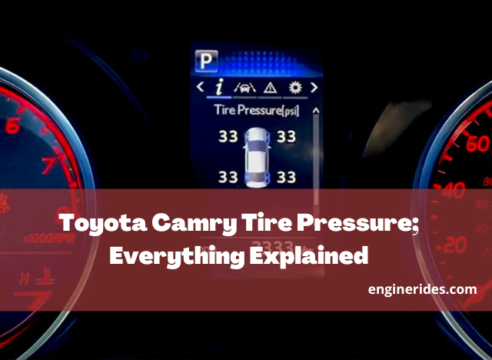Toyota Camry Tire Pressure; Everything Explained
Proper tire pressure is an essential aspect of vehicle maintenance that should never be overlooked. Regarding the Toyota Camry, tire pressure plays a crucial role in ensuring optimal performance and safety on the road.
In this article, we will delve into the importance of maintaining the correct tire pressure for the Toyota Camry and explore the steps to achieve it.
Table of Contents
What really is Tire Pressure?
Tire pressure refers to the amount of air inside a tire, measured in pounds per square inch (PSI). Each vehicle, including the Toyota Camry, has a recommended tire pressure specified by the manufacturer.
It is imperative to adhere to these recommendations to ensure proper handling, stability, and tire longevity. Various factors, such as temperature and load, can affect tire pressure, making it necessary to monitor and adjust accordingly.
Toyota Camry tire pressure for the Model years

To obtain accurate and specific information regarding the recommended tire pressure for your Toyota Camry, it is always advisable to consult the owner’s manual or the tire placard.
The tire placard, typically located on the driver’s side door jamb, contains a sticker displaying the manufacturer’s recommended tire pressure for your particular vehicle.
Regularly checking your tire pressure and making necessary adjustments is crucial. Properly inflated tires contribute to your Toyota Camry’s optimal performance and fuel efficiency.
| Model Year | Front Tires (psi) | Rear Tires (psi) |
|---|---|---|
| 2007-2011 | 30 | 30 |
| 2012-2017 | 35 | 35 |
| 2018-2022 | 32 | 34 |
Please note that the tire pressure values provided in the previous table are general recommendations for Toyota Camrys. The actual recommended tire pressure may vary depending on the specific model and tire size.
What is the Importance of Maintaining Proper Tire Pressure?
Maintaining the correct tire pressure in your Toyota Camry offers a range of benefits that contribute to your safety and overall driving experience. Firstly, it enhances safety on the road by providing optimal traction and grip, reducing the risk of accidents, especially in adverse weather conditions.
Maintaining proper tire pressure also helps improve fuel efficiency by reducing rolling resistance, thereby saving you money at the pump. Lastly, it extends the lifespan of your tires, ensuring they wear evenly and last longer, saving you money on replacements.
How to check Tire Pressure in the Toyota Camry?
Checking their pressure regularly is important to ensure your tires are properly inflated. The Toyota Camry is equipped with a tire pressure monitoring system (TPMS) that alerts you if the pressure drops below the recommended level.
However, double-checking using a tire pressure gauge for accuracy is always a good idea. Here’s a step-by-step guide to checking your tire pressure:
- Locate the tire pressure monitoring system (TPMS) button in your vehicle. It is usually located near the dashboard or instrument panel.
- Turn on the ignition without starting the engine and locate the TPMS button.
- Press and hold the TPMS button until the indicator light blinks three times. This activates the system, allowing you to check the individual tire pressures.
- Proceed to each tire and place the tire pressure gauge on the valve stem. Press firmly to ensure a proper seal.
- The gauge will display the current pressure reading. Compare it to the recommended tire pressure for your Toyota Camry.
- If the pressure is lower than recommended, add air until the desired pressure is reached. If it’s higher, release air until the correct pressure is attained.
Toyota Camry tire pressure reset procedure
To reset the tire pressure monitoring system (TPMS) on a Toyota Camry, you can follow these general steps:
- Ensure that all tires are properly inflated to the recommended tire pressure for your specific Toyota Camry model. You can find the recommended tire pressure information on the tire placard located on the driver’s side door jamb or in the owner’s manual.
- Start the vehicle and locate the TPMS reset button. In most Toyota Camry models, the reset button is typically located beneath the steering wheel or on the instrument panel.
- With the vehicle running, press and hold the TPMS reset button for about 3-5 seconds. The TPMS warning light on the instrument panel will start flashing.
- Release the reset button. After a few seconds, the TPMS warning light should turn off, indicating that the system has been reset.
- Drive the vehicle for several minutes at a speed above 15 mph (24 km/h) to allow the TPMS to initialize and calibrate with the newly set tire pressures.
Please note that the specific steps and location of the TPMS reset button may vary slightly depending on the year and model of your Toyota Camry. It’s always recommended to refer to the owner’s manual for detailed instructions and any model-specific variations.
How to maintain Optimal Tire Pressure?

Once you’ve established the proper tire pressure for your Toyota Camry, it’s crucial to maintain it consistently. Here are a few key practices to ensure optimal tire pressure:
- Inflate your tires when they are cold, as tire pressure increases when they are hot due to driving. Wait at least three hours after driving to get an accurate cold tire pressure reading.
- Adjust tire pressure according to driving conditions. If you’re carrying additional load or driving in extreme weather conditions, you may need to increase or decrease tire pressure to accommodate these factors. Refer to your vehicle’s manual for specific recommendations.
- Regularly check your tire pressure at least once a month and before long trips. Consistent maintenance helps identify any potential issues and ensures your tires remain at the correct pressure level.
What are the consequences of Improper Tire Pressure?
Failing to maintain proper tire pressure can adversely affect your vehicle and your safety. Insufficient tire pressure reduces traction and handling capabilities, increasing the risk of skidding or losing control.
Moreover, it can lead to uneven tire wear, shortening the lifespan of your tires and requiring premature replacements. In extreme cases, improper tire pressure can even result in tire blowouts, which can be extremely dangerous and potentially lead to accidents.
Conclusion
In conclusion, maintaining the proper tire pressure is vital for your Toyota Camry’s optimal performance and safety. By regularly checking and maintaining the recommended tire pressure, you can enhance your vehicle’s safety, improve fuel efficiency, and extend the lifespan of your tires.
Don’t underestimate the importance of this simple yet crucial aspect of vehicle maintenance. Take the time to check your tire pressure regularly, ensuring a safe and efficient driving experience for you and your passengers.
Some related FAQs
How Often Should I Check The Tire Pressure On My Toyota Camry?
It is recommended to check the tire pressure on your Toyota Camry at least once a month or before long trips. Additionally, inspecting the tire pressure whenever there are extreme temperature changes or significant changes in load or driving conditions is a good practice.
Can I Use The Tire Pressure From Another Toyota Camry Model Year?
Using the tire pressure specifications from a different Toyota Camry model year is not advisable. Tire pressure recommendations can vary between different model years and tire sizes. Always refer to the tire placard or owner’s manual for the accurate tire pressure information specific to your Camry.
What Should I Do If The Tire Pressure Warning Light Illuminates?
If the tire pressure warning light comes on, it indicates that one or more tires may have low pressure. Adjust the tire pressures with a gauge to the recommended levels. If the warning light persists even after adjusting the tire pressures, there might be a problem with the TPMS, and it is recommended to have it inspected by a qualified technician.
Can I Rely On The Tire Pressure Monitoring System (TPMS) Alone?
While the TPMS is a useful tool for monitoring tire pressure, it is still important to manually check the tire pressures regularly. TPMS may not always detect gradual pressure loss and cannot determine the actual tire pressure values. Manual checks with a gauge ensure accurate readings and proper tire inflation.








One Comment